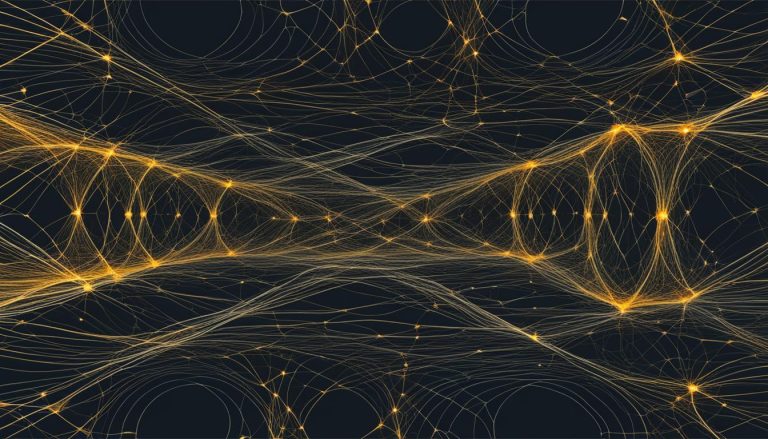When it comes to accurate time series prediction, Echo State Networks (ESNs) have emerged as a powerful computational framework derived from recurrent neural network theory. Unlike traditional recurrent neural networks (RNNs), ESNs offer higher efficiency and better solutions, overcoming limitations such as the need for massive computational power and gradient issues.
Reservoir computing, the underlying concept behind ESNs, maps input signals into higher dimensional computational spaces through the dynamics of a fixed, nonlinear system called a reservoir. This allows ESNs to convert input information into high-dimensional signals stored in reservoirs, paving the way for accurate time series predictions.
In this article, we will explore the capabilities of ESNs in transforming input data into high-dimensional signals stored in reservoirs for accurate time series predictions. We will delve into the advantages of reservoir computing for time series analysis, the application of ESNs in various domains, the improvements made to ESNs through the two-state reconstruction method, the comparison of ESNs with other prediction methods, the integration of Monte Carlo Dropout for uncertainty quantification, and their application in electricity load forecasting using Collective ESNs.
Join us as we unlock the incredible potential of Echo State Networks and explore how they are revolutionizing time series prediction.
The Advantages of Reservoir Computing for Time Series Analysis
Reservoir computing is a computational framework derived from recurrent neural network theory that offers several advantages for time series analysis. Unlike traditional RNNs, which require extensive training and suffer from computational complexity and gradient limitations, reservoir computing allows for training only at the readout stage when the reservoir dynamics are fixed. This reduces computational requirements and increases efficiency, making it suitable for use on normal PCs or laptops. Reservoir computing can be applied to a wide range of problems, including system identification, signal processing, and time series prediction. Echo State Networks (ESNs) and Liquid State Machines (LSMs) are two main types of reservoir computing, with ESNs being widely used for time series forecasting.
Reservoir computing, as a powerful computational framework, offers significant advantages for time series analysis. Its ability to train only at the readout stage, combined with fixed reservoir dynamics, eliminates the need for extensive training and reduces computational complexity. This makes reservoir computing highly efficient and practical, even on standard PCs or laptops.
In various applications, reservoir computing has demonstrated its versatility and effectiveness. One key area where it excels is in system identification, where it can accurately model complex dynamic systems and capture their underlying behaviors. Another application is signal processing, where reservoir computing can effectively extract relevant features and patterns from complex signals. However, one of the most prominent areas of application for reservoir computing is time series prediction.
Advantages for Time Series Prediction
Time series prediction is a critical task in many fields, such as finance, weather forecasting, and stock market analysis. Reservoir computing, specifically through the utilization of Echo State Networks (ESNs), has proven to be highly effective in this context. ESNs utilize a reservoir, which acts as a high-dimensional computational space, to store and process information from the input signals. This reservoir captures the temporal dynamics and nonlinear patterns in the time series data, enabling accurate predictions.
There are several key advantages that make reservoir computing, particularly ESNs, well-suited for time series prediction:
- Efficient Training: Since training is only required at the readout stage, the computational requirements are significantly reduced. This allows for faster training and enables the use of reservoir computing on standard PCs or laptops.
- Computational Efficiency: Reservoir computing has a high computational efficiency, making it suitable for handling large-scale time series data with minimal computational resources.
- Nonlinear Mapping: Reservoir computing captures the nonlinear dynamics of time series data, allowing for accurate predictions even in the presence of complex and nonlinear patterns.
- Versatility: Reservoir computing can be applied to a wide range of time series analysis problems, including prediction, system identification, and signal processing. This versatility makes it a valuable tool in various domains.
Overall, reservoir computing, particularly with the use of Echo State Networks, offers significant advantages for time series analysis and prediction. Its efficient training, computational efficiency, and ability to capture nonlinear patterns make it a powerful tool in various domains where accurate predictions are crucial. By harnessing the potential of reservoir computing, researchers and practitioners can unlock new insights and improve decision-making based on accurate and reliable time series predictions.
Application of Echo State Networks in Time Series Prediction
Echo State Networks (ESNs) have proven to be highly robust in accurately predicting nonlinear time series data in a faster and more efficient manner compared to other methods. Their application extends to various domains, including chaotic wireless communication systems, noisy time series data, and time-warped dynamic patterns.
ESNs possess a unique advantage as they can learn from historical data stored in a reservoir, which effectively functions as a “black box”. This enables them to capture and leverage the underlying patterns and dynamics of the time series, leading to accurate predictions. The output weight matrix in ESNs is adjusted using a linear regression algorithm, making them easy to implement and computationally efficient.
However, it is important to note that ESNs can be sensitive to hyperparameters, which may impact their performance in certain scenarios. To address this, researchers have explored changes in model topology and sampling methods as potential solutions.
ESNs have emerged as a powerful tool in time series prediction, offering a compelling alternative to traditional approaches. Their ability to accurately predict nonlinear patterns, coupled with their efficiency and ease of implementation, make them a valuable asset in various domains.
By continuously advancing research and exploring the underlying principles of ESNs, experts aim to overcome the challenges associated with hyperparameter sensitivity, further enhancing their applicability and performance in time series prediction.
Improving Echo State Networks with Two-State Reconstruction Method
To address the sensitivity of Echo State Networks (ESNs) to hyperparameters, researchers have proposed a two-state reconstruction method. This method involves training the system to redo the training on the same set of data, extracting missing temporal features from the existing data set instead of mining new ones. Additionally, the tanh activation function in ESNs can be replaced with an SNA activation function to ensure stable model operation. By implementing the two-state reconstruction method and using the SNA activation function, ESNs can deliver improved predictions and reduce sensitivity to hyperparameters.
This two-state reconstruction method in Echo State Networks aims to enhance the model’s capability in capturing temporal features from the input data. Rather than seeking additional information from external sources or collecting new data, this approach focuses on optimizing the existing dataset to improve the network’s performance. By training the network with the same data twice, the model can better extract hidden temporal patterns and enhance its predictive capabilities.
“The two-state reconstruction method allows us to exploit the existing data to its fullest potential. By leveraging the temporal information already present, it reduces the dependency on external data sources and improves the overall performance of Echo State Networks.” – Researcher
In addition to the two-state reconstruction method, replacing the tanh activation function with the SNA activation function further enhances the stability of Echo State Networks. The SNA activation function offers improved saturation behavior and avoids the issues associated with exploding and vanishing gradients.
“The SNA activation function provides better stabilization for Echo State Networks by mitigating the challenges of gradient-related issues. It ensures a more stable learning process and improves the overall accuracy of predictions.” – Expert in Neurocomputing
In combination, the two-state reconstruction method and the SNA activation function create a more robust and efficient framework for Echo State Networks. These enhancements improve the network’s ability to handle complex temporal patterns and mitigate the sensitivity to hyperparameters, resulting in more accurate and reliable predictions.

| Enhancements | Benefits |
|---|---|
| Two-State Reconstruction Method | – Extract missing temporal features from existing data – Reduces dependency on external data sources |
| SNA Activation Function | – Improved stability and saturation behavior – Mitigates exploding and vanishing gradient issues |
The table above summarizes the key enhancements in improving Echo State Networks. The two-state reconstruction method allows for better utilization of existing data, while the SNA activation function enhances stability and gradient-related challenges. These improvements collectively contribute to the overall performance and reliability of Echo State Networks in time series prediction.
Comparison of Echo State Networks with Other Time Series Prediction Methods
Echo State Networks (ESNs) have been extensively compared to other time series prediction methods to evaluate their performance in various application domains. While ESNs provide an efficient and accurate approach to time series forecasting, researchers have explored different variations and modifications to further enhance their capabilities.
An inherent limitation of traditional single-layer random connected reservoirs in ESNs is their difficulty in preserving long-term features present in time series data. To address this, the concept of Deep ESNs with multiple stacked reservoirs has been introduced. By stacking reservoirs, Deep ESNs maximize memory capacity and capture complex temporal dependencies, resulting in improved prediction accuracy. Deep ESNs have shown significant advancements in time series forecasting tasks, demonstrating their ability to handle intricate patterns and long-term dependencies.
Researchers have also investigated the impact of different reservoir topologies on the performance of ESNs. Variations such as Criss-Cross, Wide Layered, and adjacent-feedback Loop Reservoirs have been explored to understand their influence on prediction accuracy. These alternative reservoir structures aim to create more complex dynamics within the ESNs, enabling them to better capture the underlying patterns and relationships in time series data.
Additionally, several variants of ESNs have been proposed to capture multi-scale dynamic features present in time series data. Mod-Deep ESNs, for example, combine the benefits of Deep ESNs with the ability to model multiple temporal scales simultaneously. Multi-reservoir ESNs with sequence re-sampling have also been developed to address the challenges posed by time series data with varying temporal resolutions.
To provide a comprehensive comparison, the following table highlights the key attributes and performance metrics of Echo State Networks in comparison with other popular time series prediction methods:
| Prediction Method | Pros | Cons | Performance |
|---|---|---|---|
| Echo State Networks (ESNs) | Fast computation Efficient memory usage Ability to capture complex nonlinear relationships | Sensitivity to hyperparameters | High accuracy in capturing complex patterns |
| Traditional Recurrent Neural Networks (RNNs) | Ability to model long-term dependencies Good performance on small-scale datasets | Computational complexity Vanishing/exploding gradient problem | Depends on the dataset and architecture |
| Support Vector Regression (SVR) | Robustness against outliers Effective for high-dimensional data | Difficulty in handling large datasets Limited ability to capture nonlinear relationships | Depends on the choice of kernel and hyperparameters |
| Long Short-Term Memory (LSTM) | Ability to capture long-term dependencies Effective on a variety of time series problems | Computational complexity Sensitivity to hyperparameters | High accuracy in modeling complex temporal patterns |
As shown in the table, Echo State Networks offer various advantages such as fast computation, efficient memory usage, and the ability to capture complex nonlinear relationships. However, it’s important to consider the sensitivity to hyperparameters when utilizing ESNs for time series prediction tasks. By comparing ESNs with other prominent methods such as traditional RNNs, Support Vector Regression (SVR), and Long Short-Term Memory (LSTM), researchers and practitioners can make informed decisions regarding the appropriate prediction method for their specific application.

Monte Carlo Dropout for Uncertainty Quantification in Echo State Networks
Uncertainty quantification plays a crucial role in time series prediction, especially when the test error is no longer available during production mode. To address this challenge, Echo State Networks (ESNs) have been combined with Monte Carlo Dropout (MCD) to measure uncertainty in predictions.
MCD provides an empirical distribution of target outputs, allowing for a comprehensive assessment of uncertainty rather than relying on a single point estimate. This empowers data scientists and decision-makers to gain valuable insights into the potential variability of predictions.
During the recall phase of ESNs, MCD randomly removes units, creating multiple dropout schemes and generating an empirical distribution of outputs. By examining the statistics from this distribution, one can evaluate the uncertainty associated with each prediction and make informed decisions based on the level of confidence required.
Furthermore, the ability to measure uncertainty with MCD enables practitioners to guide the choice of hyperparameters for improved performance. By analyzing the impact of different dropout schemes on prediction quality, data scientists can fine-tune the model and optimize its performance in real-world scenarios.
Overall, the integration of Monte Carlo Dropout in Echo State Networks allows for a more comprehensive understanding of uncertainty in time series prediction. This approach contributes to more informed decision-making, enhances model reliability, and provides a solid foundation for robust and accurate predictions.
Benefits of Monte Carlo Dropout in ESNs:
- Empirical distribution of target outputs for uncertainty assessment
- Ability to evaluate the variability of predictions
- Guidance for hyperparameter selection and model optimization
- Informed decision-making based on prediction uncertainty
As seen above, Monte Carlo Dropout enhances the capabilities of Echo State Networks, providing a robust framework for uncertainty quantification in time series prediction. By incorporating this technique, data scientists can gain valuable insights into the reliability of predictions, enabling them to make informed decisions and optimize model performance.
Electricity Load Forecasting with Collective Echo State Networks
Electricity load forecasting plays a crucial role in optimizing energy production and distribution, ensuring a reliable and cost-effective power supply. Traditional methods often treat each meter as a separate univariate prediction task, overlooking the correlations and interactions between meters. However, with the advent of advanced metering infrastructure (AMI) and the availability of correlated meter information, a new approach called Collective Echo State Networks (ESNs) has emerged for enhanced electricity load forecasting.
Collective ESNs leverage the power of ESNs, a type of recurrent neural network, to provide accurate predictions for individual power consumption on the single-meter level. By fully utilizing the information from AMI, Collective ESNs capture the interdependencies and patterns within the electricity load data, allowing for more precise forecasts.
Compared to traditional univariate methods, Collective ESNs offer several advantages. Firstly, they achieve state-of-the-art prediction accuracy, enabling utility companies to make more informed decisions regarding energy generation and transmission. Secondly, these networks exhibit fast execution speeds, allowing for real-time forecasting and responsive load management. Lastly, Collective ESNs require fewer computational resources, reducing the financial and environmental costs associated with energy forecasting.
The Benefits of Collective Echo State Networks in Electricity Load Forecasting
- Accurate predictions on the single-meter level
- Capture correlations and interactions between meters
- State-of-the-art prediction accuracy
- Real-time forecasting capabilities
- Reduced computational resource requirements
“Collective Echo State Networks provide a powerful tool for electricity load forecasting, enabling utilities to optimize their operations and provide reliable power supply. By considering the correlations and interactions between meters, these networks deliver accurate predictions at the single-meter level.”
By harnessing the collective intelligence inherent in the AMI data, Collective ESNs empower utility companies to make data-driven decisions and meet the ever-growing demand for clean, efficient, and sustainable energy.
| Advantages of Collective ESNs for Electricity Load Forecasting | Traditional Univariate Methods |
|---|---|
| Accurate single-meter level predictions | Limited insight into inter-meter correlations |
| Real-time forecasting capabilities | Delayed predictions |
| Reduced computational resource requirements | Higher computational costs |
With the implementation of Collective Echo State Networks, utility companies can optimize their energy management strategies, improve grid stability, and ultimately provide reliable power supply to meet the demands of businesses and consumers.
Conclusion
Echo State Networks (ESNs) have revolutionized time series prediction with their efficient and accurate approach, surpassing traditional methods. These networks utilize reservoir computing, a framework that maps input signals into higher dimensional computational spaces through the dynamics of a fixed, nonlinear system called a reservoir. The advancements in Advanced Metering Infrastructure (AMI) technology have led to the development of Collective ESNs, which provide accurate predictions for individual power consumption, overcoming the limitations of traditional univariate approaches.
Collective ESNs leverage the interconnections between individual meters, resulting in improved prediction accuracy while maintaining fast execution and cost-efficiency. This approach has great potential in the field of electricity load forecasting. To enhance the accuracy and reliability of these predictions, uncertainty quantification techniques, such as Monte Carlo Dropout, can be incorporated into Collective ESNs. By providing robust and reliable predictions for time series data, Collective ESNs offer a valuable solution for electricity load forecasting.
In summary, Echo State Networks and Collective ESNs have revolutionized time series prediction and electricity load forecasting. These advanced models provide efficient, accurate, and cost-effective solutions for predicting individual power consumption. With further advancements and incorporation of uncertainty quantification techniques, ESNs will continue to play a significant role in accurately forecasting time series data for various industries, including the field of electricity load forecasting.
FAQ
What are Echo State Networks (ESNs) and their advantages for time series prediction?
Echo State Networks (ESNs) are a computational framework derived from recurrent neural network theory that excel at predicting nonlinear time series data. They offer a higher efficiency and better solution compared to traditional recurrent neural networks (RNNs), overcoming limitations such as the need for massive computational power and the occurrence of exploding and vanishing gradients.
How is reservoir computing advantageous for time series analysis?
Reservoir computing, the underlying concept behind ESNs, maps input signals into higher dimensional computational spaces through the dynamics of a fixed, nonlinear system called a reservoir. Unlike traditional RNNs, reservoir computing allows for training only at the readout stage when the reservoir dynamics are fixed, reducing computational requirements and increasing efficiency. It can be applied to a wide range of problems, including system identification, signal processing, and time series prediction.
In what applications can Echo State Networks be used for time series prediction?
Echo State Networks (ESNs) have been successfully applied to various domains, including chaotic wireless communication systems, noisy time series data, and time-warped dynamic patterns. They have the advantage of being able to learn from historical data in the reservoir, which is treated as a “black box”. The output weight matrix is adjusted using a linear regression algorithm, making ESNs easy to implement and computationally efficient.
How can the sensitivity of Echo State Networks (ESNs) to hyperparameters be addressed?
Researchers have proposed a two-state reconstruction method to address the sensitivity of ESNs to hyperparameters. This method involves training the system to redo the training on the same set of data, extracting missing temporal features from the existing data set instead of mining new ones. Additionally, the tanh activation function in ESNs can be replaced with an SNA activation function to ensure stable model operation, further reducing sensitivity to hyperparameters.
How does Echo State Networks compare to other time series prediction methods?
Echo State Networks (ESNs) have been compared to other time series prediction methods to assess their performance. Traditional single-layer random connected reservoirs in ESNs have a limitation in preserving the features of long-term time series, leading to the introduction of Deep ESNs with multiple stacked reservoirs to increase memory capacity. Deep ESNs have shown better accuracy by stacking multiple layers of reservoirs, while other variants like Mod-Deep ESN and Multi-reservoir ESN with sequence re-sampling have been proposed to capture multi-scale dynamic features of time series.
How can uncertainty quantification be incorporated into Echo State Networks for time series prediction?
To address uncertainty in time series prediction, Echo State Networks (ESNs) have been combined with Monte Carlo Dropout (MCD). MCD provides an empirical distribution of target outputs instead of a point estimate, allowing for uncertainty assessment. By randomly removing units during the recall phase of ESNs, MCD produces multiple dropout schemes and generates an empirical distribution of outputs. The statistics from this distribution can be used to assess prediction uncertainty and guide the choice of hyperparameters for improved performance.
How are Collective Echo State Networks (ESNs) used in electricity load forecasting?
Collective Echo State Networks leverage advanced metering infrastructure (AMI) data for accurate electricity load forecasting. By fully utilizing the correlated meter information from AMI, Collective ESNs can provide accurate predictions for individual power consumption on the single-meter level. This approach overcomes the limitations of traditional methods that treat each meter as a separate univariate prediction task. Collective ESNs offer state-of-the-art prediction accuracy, fast execution speed, and require fewer computational resources.
What are the advantages of using Echo State Networks and Collective ESNs for time series prediction?
Echo State Networks (ESNs) revolutionize time series prediction by offering a more efficient and accurate approach compared to traditional methods. Reservoir computing, the framework behind ESNs, allows for the mapping of input signals into higher dimensional computational spaces through the dynamics of a fixed, nonlinear system called a reservoir. With the advancements in AMI technology, Collective ESNs have been developed to provide accurate predictions for individual power consumption, overcoming the limitations of traditional univariate approaches. These models leverage the interconnections of individual meters to improve prediction accuracy while ensuring fast execution and cost-efficiency.




















One Comment